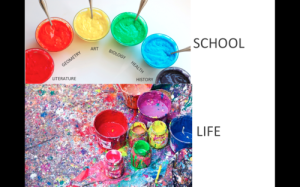I have been witness to much discussion of late across various school sites that I have visited regarding the difficulty of integrating math and science using an inquiry approach. While this discussion could stem from educators who do not have a clear understanding of multi-disciplinary approaches or inquiry-based learning, it is interesting that this has been a common area of discussion by educators across a variety of contexts. In the discussions that I have been involved in, there are three main issues I have identified that are often raised by Math and Science educators in particular. These are:
1. Math and Science lend themselves more to content-driven instruction.
2. Math can not be integrated with any other subject.
3. Both Science and Math need teacher-lead direction to ensure that learning occurs and this isn’t possible in an inquiry unit.
The video below provides an excellent example of an integrated math/science/english (whether intentional or not) unit on Decomposition using an inquiry process to guide student learning and suggests that it is possible to integrate both math and science using an inquiry approach.
The Decomposition Unit undertaken in the example above demonstrates purposeful integration at its best, as the seamless inter-disciplinary approach is complemented by an inquiry process. While the learning that takes place in this unit is student-driven, there is great evidence of teacher preparation, direction and guidance throughout the inquiry process. Initially, students become engaged and immersed in the unit through teacher-directed content that introduces them to the concepts being examined. The students are then prompted to brainstorm as a class the questions they would like to examine in the unit. Students were also involved in the selection of assessment criteria through defining what they believed the quality of their work would look like under the specific school-identified key areas of: inquiry, knowledge and skills, communication, enhancing and supporting community and work habits. This process allowed both students and staff to define and have a clear understanding of what quality work would look like.
This introductory/immersion process allowed teachers to engage students in the topic of learning and provide them with the content, knowledge and understanding they needed before the students were handed the reigns and allowed to start their own investigations. I believe the detail and time the teachers of this unit took in preparing their students for learning in this unit, is one of the reasons it was such a success, as every learner was engaged, had a problem to solve and knew the process they would take in the search for answers.
The scientific study regarding the nature of decomposition provides the foundations of this inquiry, however the skills required by the students to measure, gather, document and graph data provide a clear cross-over into math, as does the blogging and reflection process to English. What provides the greatest evidence of purposeful integration in this unit, is that students are not at any stage focussing on a particular discipline, rather, they are using the inquiry process to build understanding and many of the skills mentioned in the Australian Curriculum General Capabilities in a quest to explore and build on their knowledge and skill set. The involvement of teachers and the wider community was obvious in the unit, however, this involvement acted to guide and complement the learning that happened, rather than direct and control this learning.
This is just one example, of the way in which inquiry and purposefully connected curriculum can enhance not hinder the learning of students regardless of the disciplines being studied.
